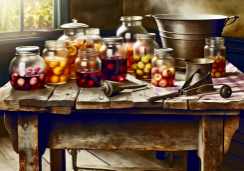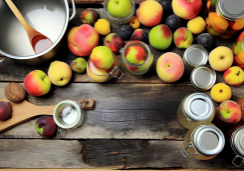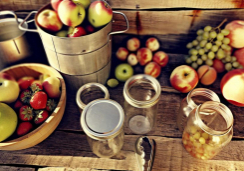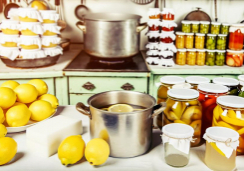Home Smoking Meats: A Culinary Tradition Unveiled
Nearly 75% of Americans own a smoker or grill, reflecting your collective love for the deep, aromatic flavors that only the ancient art of smoking can impart to meats and seafood. As you stand before your home smoker, you're not just preparing a meal; you're engaging in a ritual that spans centuries and continents, a tradition steeped in technique and patience.
You've likely pondered the complexity behind choosing the best cuts of meat, the nuances that differentiate oak from cherry wood, or the precise heat control needed to transform a simple piece of protein into a mouth-watering delicacy. Yet, what may not be as apparent is the rich tapestry of history and culture interwoven with the smoke that curls from your backyard.
Join us on a journey that goes beyond the smoker – to where the brine and the smokehouse are as much about crafting flavors as they are about preserving heritage.
Choosing Your Meat
When selecting your meat for smoking, it's crucial to consider both the type and the cut, as these choices will greatly influence your cooking techniques and the final flavor profile of your dish. A pork shoulder, for instance, lends itself beautifully to slow cooking, allowing the smoky flavor to permeate deeply. The right cut, with its marbling of fat, will ensure tenderness and a rich taste in your smoked meats.
To elevate your craft, match the wood to the meat. Hickory pairs well with robust meats like pork shoulder, while lighter woods like cherry or apple complement subtler flavors. The preparation can't be overlooked—brining or seasoning the meat before smoking adds complexity to the taste and aids in moisture retention.
Understanding smoking temperatures is also key. Pork shoulder thrives at lower temperatures, which gently breaks down the connective tissues over several hours. This patience results in a masterpiece of succulence and taste. And remember, smoking time isn't a detail to gloss over. It varies by meat type and size, so keep a vigilant eye on your prized creation.
Mastery of these elements will ensure smoked meats that are nothing short of remarkable.
Selecting the Right Wood
After choosing your meat, it's time to focus on the wood, as the right selection is just as critical to the smoking process. The art of smoking meat is steeped in the tradition of attention to detail, and the selection of wood will determine the depth and nuance of the smoky flavors you'll impart.
Opt for hardwoods like hickory or maple to ensure a consistent burn and reliable flavor. Hickory, in particular, is renowned for its strong, smoky taste and the rich amber hue it lends to your meat. It's a classic choice that pairs well with robust meats like beef or pork.
If you're after something a bit subtler, fruitwoods such as pear or cherry are your allies. They'll caress your meats with a mild sweetness and impart a delicate color that's as pleasing to the eye as it's to the palate.
Steer clear of softwoods or any wood that's high in sap, green, or treated. These can release harmful chemicals or overpowering, acrid smoke that will spoil your culinary canvas.
Preparing the Smoker
Before igniting your smoker, ensure it's immaculately clean to prevent past flavors from tainting your meat's smoky profile. Residue from previous sessions can be intrusive; a thorough scrubbing guarantees the true essence of the wood you've selected shines through when imparting a smoky nuance to your meats.
Once your smoker is spotless, it's time to season the interior. Coating the surface with a high-smoke point oil and running the smoker at a high temperature for a short period will create a protective layer. This ritual is as essential as the smoking process itself, safeguarding your smoker and enhancing the overall flavor.
Now, gently preheat your smoker. Whether you're aiming for the robust intensity of hot smoking or the delicate touch of cold smoking, the temperature must be precise. Ensure your smoker reaches the desired heat level before introducing your meat.
As your smoker warms, arrange the wood chips or chunks so they'll smolder consistently, avoiding flare-ups and ensuring a steady stream of smoke. Monitor the internal temperature closely. Your vigilance ensures the environment within remains stable, allowing your meat to absorb the smoky character evenly and ensuring it will fit inside the smoker without overcrowding. This care is what transforms a simple meal into a crafted culinary experience.
Managing Smoking Temperatures
To master the art of smoking meats, you'll need to maintain precise control over the internal temperature of your smoker, adjusting airflow and dampers as necessary to create the perfect smoking conditions. This is where your craftsmanship truly shines.
The smoky allure of perfectly smoked meat is achieved through careful monitoring and managing smoking temperatures. Here's a detailed guide to ensure you infuse your meats with the rich smoke flavor you're aiming for:
- Consistent Temperature Monitoring: Use a reliable thermometer to check the temperature regularly. A steady heat is crucial for even cooking and flavor distribution.
- Airflow and Damper Adjustment: Learn to control the airflow. This will affect how hot your fire burns and thus the temperature inside your smoker.
- Water Pan Utilization: Introduce a water pan into your smoker. It'll help stabilize the temperature and add moisture to the environment, preventing your meats from drying out.
- Wood Type and Quantity: Different woods impart different flavors. Experiment with wood types and amounts to find the perfect balance for your palate.
Finishing and Resting Meats
Once you've mastered the steady flame and the dance of smoke within your smoker, it's time to focus on the critical stage of finishing and resting your meats to encapsulate the flavors and achieve the tender perfection sought by artisans of the craft.
The resting phase isn't merely a pause in the process; it's an art in itself, ensuring that the rich flavors developed during smoking are perfectly preserved.
As you remove your smoked salmon or other meats from the heat, wrap them gently, creating a haven for the natural flavors to mature. The juices, once roiling under the heat, now settle back into the fibers, redistributing evenly. This interval is essential; it allows the meat to relax, the moisture to be reabsorbed, and the flavor profile to deepen.
Resist the urge to cut into your creation immediately. Let the meat sit, covered loosely with foil, to retain warmth without becoming soggy. This rest period, lasting from a few minutes for smaller cuts to several hours for larger ones, ensures a succulent texture and a consistent doneness throughout.
When you finally slice into your masterpiece, you'll find it has retained its juiciness, making every bite a testament to your patience and skill.
Frequently Asked Questions
What Do You Call Someone Who Smokes Meat?
You'd call a meat enthusiast with smoke mastery and a knack for flavor a pitmaster. They're the flavor artisans who've refined their pitmaster profile through practice and a deep understanding of the craft.
What Is the Traditional Way of Smoking Meat?
You'll traditionally smoke meat by choosing the right wood, applying cold smoke, and using time-tested flavor enhancement techniques for both preservation and a rich, smoky taste.
When Did People Start Smoking Meats?
You've likely wondered about the roots of smoking meats. It's an ancient preservation method, with cultural origins spanning the globe. This technique has honed flavor development and various global techniques throughout history.
What Is the Traditional Smoking Process?
You'll use smoking woods to infuse smoke flavor, ensuring temperature control for safety. This preservation method, steeped in tradition, gives your meats a rich, distinctive taste through meticulous, artisanal techniques.
Conclusion
Now you've mastered the smoke, it's your turn to craft unforgettable flavors. Choose your cuts wisely, pair with the perfect wood, and tend your smoker like an age-old art.
Keep a keen eye on those temperatures; they're the key to unlocking rich, savory notes.
And don't rush the finish—let your meats rest, letting every succulent bite pay homage to the tradition you've lovingly upheld.
Go ahead, savor the fruits of your fiery labor.










